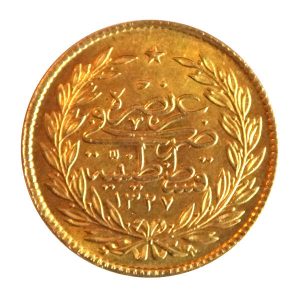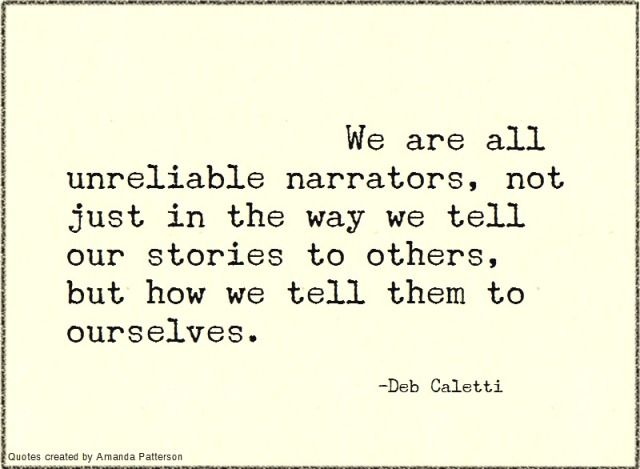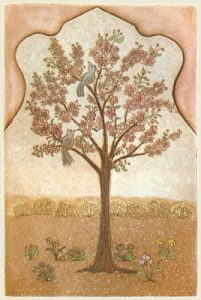Chapter 19, “I am a gold coin”, really emphasized the theme in this novel of real vs imitation, as well as honesty vs deceit. The coin speaks to us, telling us of its journeys from hand to hand, and then reveals to us that it is actually counterfeit gold. The idea of counterfeit money is interesting–if no one can tell it is counterfeit, and the money is accepted by all, then no one will ever be cheated from the coin. This plays to the idea of imitation from the miniaturists. The Eastern way of painting was to paint such that paintings of new and old were indistinguishable, and style was nonexistant– essentially imitation. I think the parallels between the circulation of counterfeit money and the circulation of imitated paintings is an interesting pairing. The coin also points out that it essentially drives all desires. On page 106, it states “If I didn’t exist, however, no one would be able to distinguish a good artist from a bad one, and this would lead to chaos among the miniaturists; they’d all be at each other’s throats.” This quotation describes how money is used to distinguish miniaturists in their art–even though they are not supposed to paint for glory/money and instead paint for Allah, money unavoidably exists as a source of competition between the miniaturists. 
“Real” Life
In My Name Is Red, the Sultan states, “An illustration that does not complement a story, in the end, will become but a false idol. Since we cannot possibly believe in an absent story, we will naturally begin believing in the picture itself.” (Pamuk 109). This quotation highlights the significance of what pictures mean, and how they often twist our sense of reality. With this, the artist has an immense responsibility when depicting a story.
In my Russian Literature course we recently discussed how we narrate our own lives. We make sense of the threads of our lives be spinning them into stories. Whether conscious or not, we often embellish or leave out moments in order to provide a logical series of events.
In this way paintings are stories of stories. The layers of fiction build on one another. Like the Sultan says, “We believe in the picture itself” regardless of its origins. There’s something beautiful in illuminating our lives and illuminating stories. We are the artists of our lives.

Blindness in “My Name is Red”
One prominent theme in Orhan Pamuk’s My Name is Red is sight and its opposite: blindness. These two terms each have certain connotations depending on the context and who is speaking about them throughout the novel. In class, we noted that Master Osman scrapes away the eyes in some paintings since eyes can symbolically connote individuality and uniqueness of an artist’s lens and the subject of their depiction (321).
Many characters explain the Eastern theory that the masters among the miniaturists should be able to go blind from their strenuous work and still be able to depict things in Allah’s perspective due to their memory and the imbedded nature of the craft, which they’ve done for so long. Some like Olive, in his Three Stories on Blindness and Memory, go as far to say that blindness actually helps them in seeing this: “‘Since my eyes will no longer be distracted by the filth of this world, I’ll be able to depict all the glories of Allah from memory, in their purest form'”(77).
I wonder if you could see this idea of blindness in a reverse perspective – while allowing miniaturists to focus on Allah’s perspective and the craft they’ve trained themselves to know, it also disables them from seeing anything outside of that. As it’s typically thought of in the Western perspective, blindness is restrictive. And if Master Osman ultimately tries to blind himself because he wishes to see in concepts, then he is also allowing himself to not be tempted by any other possibly contradictory perspectives. In the Eastern perspective pushed by certain characters in the book, there is a power to limiting the extent of the world that you can see (and deem as important) through physical blindness and selective memory.
Complexity of Portrayal
In “My Name is Red,” ideas and concepts are presented to miniaturists that one might assume are impossible to portray in picture form. One instance, in Chapter 24 (“I am Death”), a tall, mysterious old man tells a miniaturist, “Now then, draw Death for me”. The miniaturist responds, “I cannot draw a picture of Death without ever, not once in my entire life, having seen a picture of Death”. The wise old man argues back, “You do not always need to have seen an illustration of something in order to depict that thing” (Pamuk 125).
The old man’s response brought me back to my childhood when I would read picture books every night before bed. The books were typically educational, and sought to teach me (and any other children reading them) about life values or concepts. For instance, showing gratitude. How does one depict a lofty idea like gratitude?
Our study of images thus far in the course has made me reevaluate my question. In illuminated manuscripts like the Très Riches Heures, ideas and concepts are portrayed all the time. Patrons want to be seen as kind, and want their servants to be depicted as happy. Therefore, one must depict what they feel about happiness or kindness, portray what comes to mind, and make the viewer feel it too. It is personal interpretation that sparks audience interpretation. Is this always effective? Do we always succeed? Likely not, but it is the attempt to do so that gets any artist one step closer to reaching his/her viewers.
Thinking About How Art Was Supposed To Be Viewed…
During today’s class I was particularly intrigued by the exercise we did with the Persian documents. We compared how the documents looked with the lights on and with the lights off. As a class, we concluded that there was a difference when the documents were looked upon under a different lighting.
Seeing as these documents were constructed in the 16th century, they were not created when electricity was invented. Present day individuals forget that a great percentage of the artwork they view is not in its intended situation from when it was created. For example, we read Shakespeare plays as if they were novels. However, Shakespeare never intended his plays to be read, rather they should have only been viewed as a performance. When we relate this information back to the Persian documents, our reaction when the lights were turned off is most likely how these pieces of art were viewed at the time of their creation. While candles and natural light existed in the 16th century, modern lighting has manipulated the way we view these documents in present day. It is interesting to think about how we view art and how it was intended to be seen when it was created.
It Is… Yet It Isn’t
My Name is Red by Orhan Pamuk is definitely a challenging read. It is a book that requires the reader to critically think throughout. With all of the different characters that tell their story, it can be difficult to know when to take the words in the book literally, and when to use critical thinking to make sense of the story.
The chapter “I am a Tree,” requires the reader to think a little harder to understand what is going on. I had many questions at the beginning of the chapter. Why does a tree have a chapter to itself? How can a tree even speak? What is the importance of this tree to the story as a whole? It seemed like a completely random decision by Pamuk, but the more I am reading, the more I am realizing how deliberate Pamuk is with every word choice he makes in this book. I became aware of the connection of the tree to the book in the very last paragraph of the chapter.
“I the humble tree before you, have not been drawn with such intent. And not because I fear that if I’d been thus depicted all the dogs in Istanbul would assume I was a real tree and piss on me: I don’t want to be a tree, I want to be its meaning.” (Pamuk, 51)
After reading this, I realized that that tree was a picture all along. This explains why it belongs in a book about illuminations. The tree had actually simultaneously given the perfect description as well as an example of a meta picture, which is a picture about itself.
This reminded me of the image above. The caption translates to, “This is not a pipe.” Scott McCloud explained in his book Understanding Comics: The Invisible Art that the image means to say that is a picture of a pipe and not a real, tangible pipe itself. Yet another meta picture.
Metafiction
In class up to this point, a good portion of our time has been spent discussing the concept of metapictures (images that in some way acknowledge their essence as pictures, and comment upon themselves). In Orhan Pamuk’s novel, My Name Is Red, we encounter for the first time what I believe to be a related concept, metafiction. While there have been several examples of metafiction present in the portion of the novel that I have completed, the most powerful and clear cut example came in the third chapter, which is titled I Am A Dog. In this chapter the dog, who is the narrator, says, “I’m a dog, and because you humans are less rational beasts than I, you’re telling yourselves, ‘Dogs don’t talk.’ Nevertheless, you seem to believe in a story in which corpses speak and characters use words they couldn’t possibly know” (Pamuk, 11). It is clear to see here, especially in the final sentence of the excerpt, that the dog is in fact addressing the reader, and in doing so the dog makes clear that they know they’re a character within a novel. The dog comments upon it’s reality within the pages of the book by addressing the reader. Throughout his novel, Pamuk has self-consciously alluded to the artificiality of his work by departing from traditional novelistic conventions and employing the use of metafiction. I’m interested to see if Pamuk uses this technique at other points later in the novel.
Art Beyond What is Accepted
After today’s class, there was one quote that we were reviewing from My Name is Red which truly stood out to me. This quote was, “Painting is the silence of thought and the music of sight.” I found this to be an incredibly important quote because it truly gets at the essence of the issue of this book. Is it an illuminators job to just blindly produce images that are accepted by society, or is it the artists job to represent and express their emotions and use these emotions to depict the world they see around them? Pamuk writes an entire novel of the transition from an Eastern world to a Western world, and how art and culture are developed as a result of this. The quote above highlights the same transition from creating art that is thought to be appropriate to the public to creating art that shows true artistic expression. I also find that he calls it “the music of sight” because yes these artists are producing what they see, but the “music” comes from their idealization of reality. This use of idealization was extremely common in Western 16th century art.
An example where I can see this transition is the first image we saw in class today that represented the love story that Pamuk’s novel is based on. The artist is rejecting common ideals and notions for what is acceptable in Eastern culture. It is completely new to have a man gazing upon a nude woman, who at the same time invites her in with her gaze. This is also seen when the Modernist artists beginning in the 19th century began developing what was acceptable in art with regards to nudity and gazing. Prior to this movement only nymphs and gods were depicted naked, but now they were allowing ordinary women to be naked, and they were accepting the viewers gaze at the same time. This can be seen in Edoard Manet’s Olympia (1856).
She was not a goddess or a nymph, but still was the sole focus of a painting and was completely nude. She also was staring directly at the viewer drawing their attention to her nude figure. So truly being an artist and painting is more than just the thought of the spectator and the thought of what is acceptable, but art is about the music in an artist’s soul.
I Am A Tree
“I don’t want to be a tree, I want to be its meaning.” – I Am A Tree, p. 51
This chapter is written from the perspective of a tree, which was drawn on a sheet of paper that was meant to be included in a manuscript, but never made it into the final product. Immediately before this quote, the narrative voice of the tree states that they are glad they are not drawn in the new style, in which a tree would be drawn in such detail that anyone looking at the picture could select that particular tree out of all the trees in a forest.
This quote leads me to question how it is possible to depict the meaning of a tree. Can the meaning of a tree be conveyed without drawing the tree in great detail? When creating an illumination, an artist strives to uncover the meaning of a scene or object. But as the audience views the illumination, they are left with their interpretation of what they see. The meaning of the tree will first be filtered through the mind of the artist and then through the mind of the audience.
This quote, when taken with the text before it, seems to suggest that the new style of of painting involves the addition of great detail, but the loss of the meaning behind the painting. This thought was counterintuitive to me, because I would normally think that the addition of detail expresses the meaning of an illumination more fully. Perhaps this tree was meant to be a symbol of something greater and by adding detail to the tree, the audience is distracted from that symbolism.
November/December vs. The World
I’ve been looking at the Très Riches Heures a lot over the past couple of days, and one of the questions I’ve been asking myself is why the last couple months of the calendar (completed by a different artist) are considered problematic. I guess it’s just because the brothers who did most of the work didn’t live to complete it, and people are sad for the sake of their vision. That’s all I can do to account for it, because November and December appeal to me more the other plates.
Of course, my personal preference has nothing to do with their worth as judged by art historians and critics. But from my own experience I can say that these two illuminations remind me more of more modern paintings. Their shadowy nature, the encroaching woods, the dark backgrounds and red clothing, and peasants featured as protagonists all remind me a little of Dutch and German renaissance paintings.
You know, things kind of like these. November and December aren’t nearly as sophisticated, but they’re closer, I’d say, to later art than the rest of the Très Riches Heures. That might make them a poorer example of a medieval manuscript (and I will admit that they aren’t nearly as colorful), but it doesn’t make them poorer artworks. It’s to the credit of the artist that he branched out.






